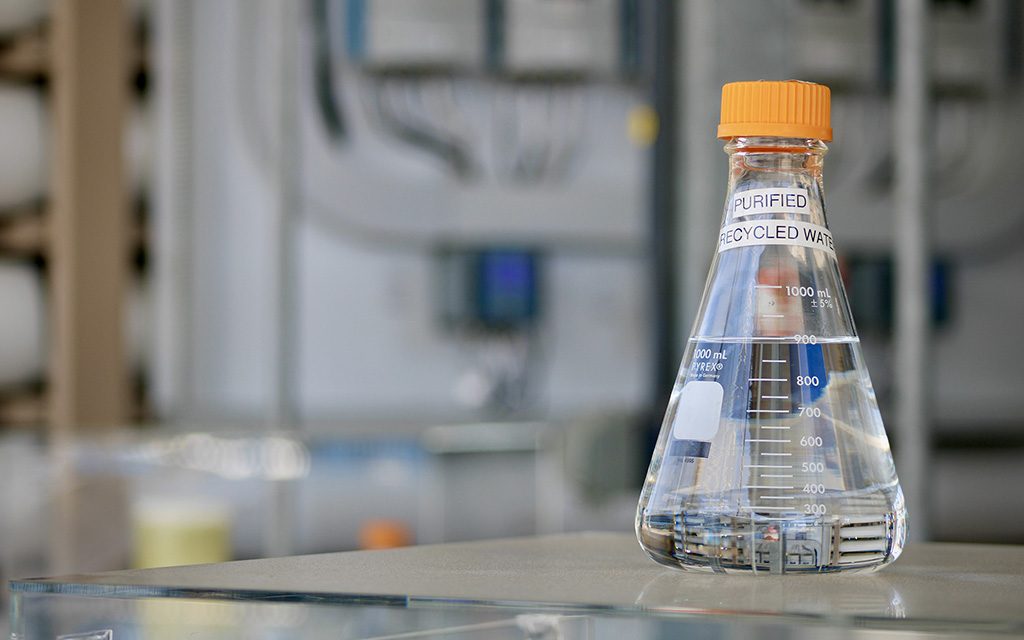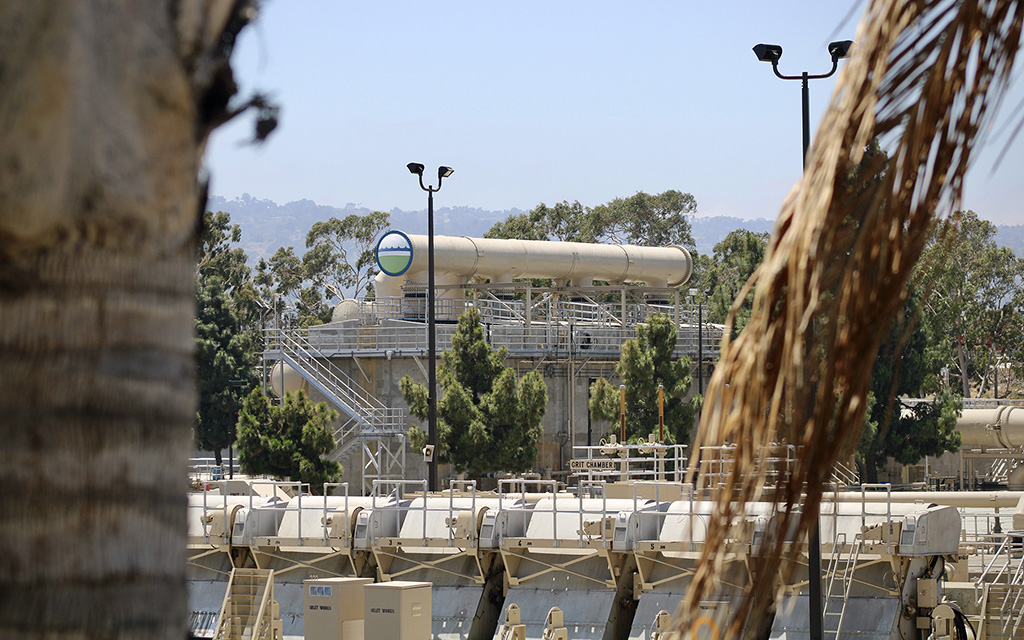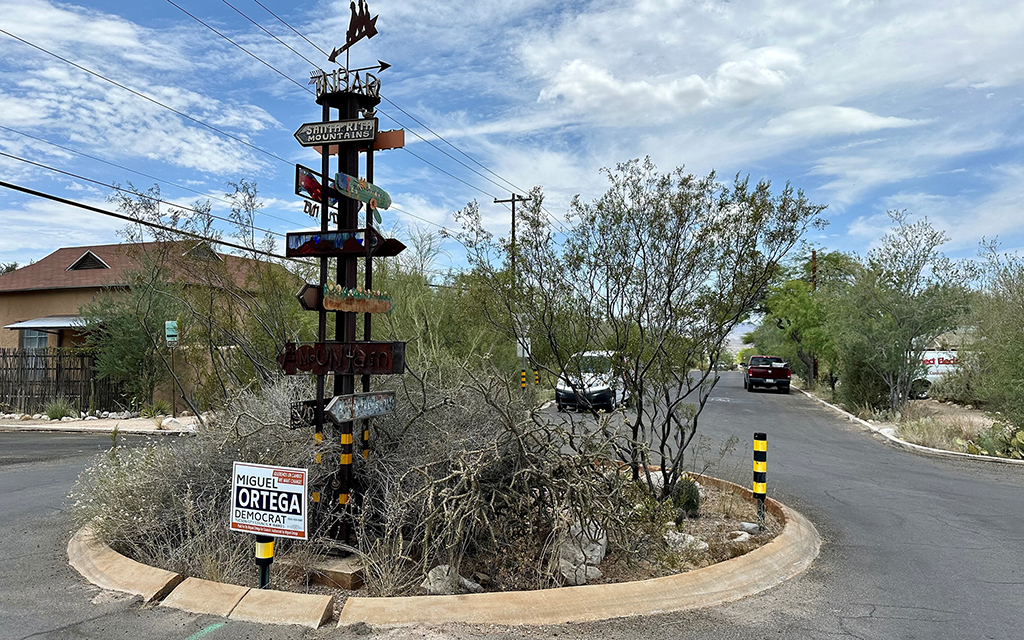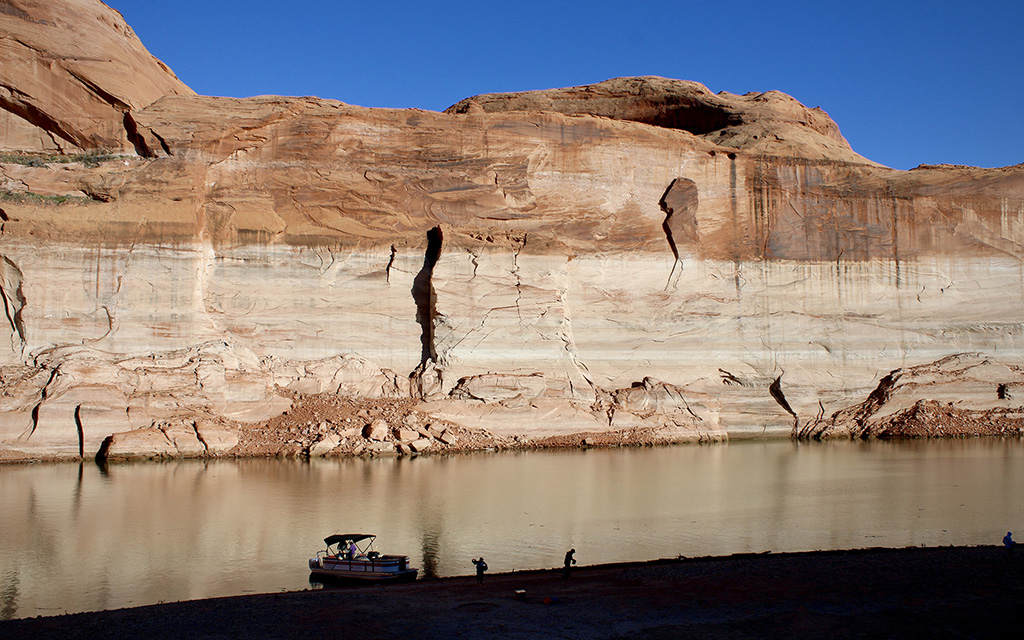
Purified recycled water fills a flask after a demonstration in Carson, California, in May 2022. The Metropolitan Water District of Southern California hopes to finish a multibillion-dollar expansion of the facility, a project that has drawn financial support from water agencies in Nevada and Arizona. (Photo by Alex Hager/KUNC)
It looks like a normal glass of water. It’s clear, cold and tasteless. But just a few hours ago, it was raw sewage.
That water is the end product of a process and technology known as water recycling, or direct potable reuse.
In the Western U.S., there’s more demand for water than there is supply, so cities with finite water supplies are finding creative new ways to stretch out the water they already have. For some, that means cleaning up sewage and putting it right back in the pipes that flow to homes and businesses.
Colorado this year passed a law with regulations for cities that want to take advantage of direct potable reuse, setting standards for water quality and requiring cities to do public outreach about the filtration process. Arizona, Texas, Florida, and California have published guidelines for the technology, but Colorado is the first state to implement a set of mandatory rules.
The process is expensive, and the new standards are stringent. But for growing cities with limited water, the opportunity to squeeze every last drop out of that finite supply is an attractive proposition.
“We pay a lot of money to get a water supply,” said Mark Marlowe, water director for the town of Castle Rock, Colorado. “The last thing we want to do is just put it back in the river after we use it and let it go downstream for someone else to use it for free.”
Castle Rock, a suburb between Denver and Colorado Springs, has been among the fastest growing cities in the state and country, according to Census Bureau data. Between 2010 and 2020, the town’s population grew by nearly 52%.
All that growth means increased stress on the underground aquifers that are Castle Rock’s primary water source. The town has started to buy and import water from Denver and Aurora, larger cities about 30 miles north, but Marlowe’s department is laying out plans to alleviate some of the city’s water constraints with direct potable reuse.
Castle Rock approved a proposal to double the size of its water treatment plant and possibly allow for direct potable reuse. Marlowe said construction costs would be upwards of $60 million.
“It’s not inexpensive,” he said. “But when we look at our other options, it certainly makes sense in Castle Rock.”
Designers of the state’s new regulations for water reuse said the high cost of equipment was part of the reason they issued the rules in the first place.
“The treatment required to do direct potable reuse is expensive enough that they need to understand where the goalposts are going to be so (municipal leaders) can put it in their long-range budget and make it economically viable,” said Tyson Ingels, lead drinking water engineer for the Colorado Department of Public Health and Environment.
Ingels said there aren’t any Colorado cities currently using direct potable reuse, but there could be “anywhere from three to several dozen” with such systems down the road. Castle Rock plans to get a system online in three to five years.
Before Colorado passed new reuse guidelines in January, state law divided all drinking water sources into two categories – groundwater and surface water – each with its own set of standards for making water safe to drink. The new rules add a third source, “treated wastewater” that has to go through extra treatment and filtration steps before it’s considered safe for consumption.
Ingels and others who deal with treated wastewater make one thing clear: They really don’t want you to think about it as former sewage. At a May conference specifically focused on water reuse in Boulder, Colorado, Ingels said the basic idea of reusing water is “old hat.”
“When you pull in water from a creek or a reservoir you are pulling water and understanding that it’s been contaminated by geese, elk or another community and you need to do the proper purification steps to make it safe,” he said. “Those concepts are the water cycle. There’s a finite amount of water on the planet, and so we already know that it’s going to recycle and be reused.”
Roadblocks remain
Water reuse, at the highest level, is a time-tested practice and newfangled direct potable reuse systems employ a rigorous purification process, but people are still skeptical. Few people know that better than Birgit Landon.
Landon, the community education specialist for Colorado Springs Utilities, roamed the area showing people how direct potable reuse works. She took a demonstration trailer rigged with pipes, pumps and filters around Colorado Springs for four months and saw plenty of raised eyebrows.
“They told me it’s the ick factor,” said Landon, “Really, It’s just the visual. It’s the idea. It’s the ick factor that makes them go, ‘No way.’”
People said they would use recycled water to water their lawns. They were OK using it to refill toilets, even for washing clothes and dishes. But the prospect of drinking gave some pause.
After taking almost 1,000 people on tours of the demonstration trailer, Landon said she was able to convince the majority. About 85% opted to taste the purified water.
The key, she said, was twofold. The first was all about semantics. Before she could convince people to drink treated wastewater, she had to figure out what to call it, which led to “several sleepless nights.”
The national WateReuse Association recommended they call it “advanced purified water.”
“When we ran that by our customers they were like, ‘Yeah, we don’t really know what that means. Just as a layperson, what is advanced purified water? That sounds a little fishy. What is it really?’” Landon said.
In the end, Colorado Springs customers said to keep it simple and be upfront. If you’re recycling water, call it “recycled water.” In the end, the utility department went with “purified recycled water.”

A pipe carries treated wastewater at a demonstration water recycling facility in Carson, California. Experts say careful wording and transparency can help cities convince a wary public that recycled water systems are safe and trustworthy. (Photo by Alex Hager/KUNC)
The second biggest factor in getting people on board with wastewater reuse was the interactive nature of the demonstration setup. In addition to the trailer and the taste testing, Landon’s crew had sodas made with recycled water.
“We had things to touch, smell and do,” Landon said. “And when they felt part of it, that’s, I think, what really swayed them.”
Landon said the “full transparency” approach was the right choice for Colorado Springs. Their efforts were aided, she said by the city’s large military population. Some who had served overseas had already lived in places where similar systems are fully operational.
The effectiveness of public outreach was not lost on the designers of Colorado’s water reuse regulations, which require cities to do some public education as they begin to install new filtration systems.
Sushseera Pochiraju, a water engineer at the New York-based firm Hazen and Sawyer, said people from younger generations are primed to get on board with direct potable reuse systems.
“There’s still a bit of fear, but it’s getting easier. This generation is much, much more aware because they’re scared for their next generation and their children, basically. So in that way, they have to accept at some point that this is safe and this is what we need.”
Pochiraju and other experts agree: The efficacy of direct potable reuse is not up for debate. The science supports it as completely safe for those who drink it.
“This is actually safer than conventional processes because we are doing more checks and balances,” Pochiraju said.
The technology has a proven track record in other parts of the U.S. Pochiraju cited Wichita Falls, Texas, where a historic drought forced the city in 2011 to fast-track a new direct potable reuse system as reservoir levels fell. It ran for 12 months before rain returned, with no health effects or quality issues.
Around the basin
Colorado isn’t the only state in the West that’s investing in new water reuse rules and technology.
Tens of millions of people from Wyoming to Mexico rely on the Colorado River, and the region’s water lifeline is getting drained by an imbalance between supply and demand. The river basin contains some of the nation’s fastest-growing cities and suburbs, with Phoenix, Las Vegas, Denver and their surrounding areas adding stress to the system.
While those expanding urban areas need water, 80% of the Colorado River is used for farming.
As more people vie for a piece of the pie, the pie itself is shrinking. Climate change is driving up temperatures around the region, making water supplies smaller and unpredictable. Heat has changed the way snow falls, melts and enters the river, resulting in historic low levels at Lake Powell and Lake Mead.
The rules that govern how the river is shared were written in 1922, when water was more abundant, and recent changes to the rules have done little to bridge the gap between supply and demand. The current rules expire in 2026, and the region’s top water policy makers are fighting over how to rewrite them before then.
Along the way, cities have been forced to stretch the supply across those growing populations. Colorado Springs, for example, uses roughly the same amount of water now as it did in the mid-1980s, despite population growing by 92% during that time.
With so much uncertainty, municipal water users are willing to spend big bucks to find even more water within existing systems. In California, water managers are ready to sink billions into perhaps the most high-profile direct potable reuse project in the West.
A proposed facility in Carson, California, is projected to cost $3.4 billion to build and $129 million a year to operate. The Metropolitan Water District of Southern California, which supplies water to about 19 million people in six counties, says the facility could go online in 2032. When done, it could send up to 150 million gallons back into the municipal supply in and around Los Angeles instead of pumping it into the ocean as it does today. That’s enough recycled water to serve more than 500,000 homes.
The facility’s operators have set up a demonstration site at a sewage treatment plant to convince policymakers and the public that the project is worth supporting. So far, it seems to be working.
Metropolitan has drawn major financial support from other anxious water suppliers in the Colorado River Basin. The Southern Nevada Water Authority, which has been praised as a poster child for water conservation for its efforts in and around Las Vegas, is ready to contribute $750 million to help get the Carson facility online.

Palm fronds frame a Carson, California, wastewater treatment plant that pumps more than 200 million gallons of treated water into the ocean each day. A proposed enhanced filtration system could let the facility clean that water even further, making it potable and pumping much of it directly back into the area’s drinking water supply. (Photo by Alex Hager/KUNC)
The Central Arizona Project, which brings Colorado River Water to the Valley, and the Arizona Department of Water Resources agreed to contribute up to $6 million to the facility’s environmental planning phase.
Once California’s new recycling setup is online, Metropolitan will have more water in its own system, and will not need to draw as much from Colorado River reservoirs such as Lake Mead, making that water available to the partner agencies in Nevada and Arizona.
The federal government is also providing financial support: The Bipartisan Infrastructure Law includes roughly $310 million for water recycling development nationwide, including 20 facilities in California alone.
As the project in Carson picks up steam, California officials have proposed their own set of regulations for water recycling in the state, and are set to hold a public hearing in early September.
While water experts around the Colorado River Basin see promise in water recycling as a way to stretch out existing supplies, they caution that should be seen as just one tool in the toolbox to keep the West’s taps flowing, and say that significant policy overhauls are still needed.
-This story is part of ongoing coverage of water in the West, produced by KUNC in Colorado and supported by the Walton Family Foundation. KUNC is solely responsible for its editorial coverage.

